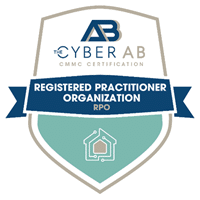Cybersecurity Solutions for Small Businesses
Cybersecurity Essentials: Toolkit for Small Businesses
In an era where digital threats loom over businesses of every size, cybersecurity is no longer optional, it’s essential. For small businesses, particularly in the manufacturing sector, the stakes are higher than ever. Contrary to common misconceptions, smaller organizations are not “too small to target”; they’re often seen as the easiest prey due to limited defenses. According to the Small Business Association, nearly 43% of cyberattacks in 2023 targeted small businesses, underscoring the urgent need for robust protective measures.
To shed light on this critical issue, we bring insights from Scott Dawson, President of Core Business Solutions, and Reagan Jorgensen, Security Solutions Technician. Together, they explore why small businesses must take cybersecurity seriously, the most common types of cyberattacks, and practical steps to build resilience against evolving threats.

Why is Cybersecurity Particularly Important for Small Businesses?
Contrary to popular belief, small businesses are prime targets for cybercriminals. Cybercriminals increasingly target small businesses due to perceived vulnerabilities in their security measures.
Threats like ransomware, phishing, and data breaches can have devastating effects, from financial loss to damage to your business’s reputation.
A small manufacturer might think they’re under the radar, but they’re a prime target for attackers looking to exploit weak security for valuable data or to disrupt operations.
Implementing foundational cybersecurity practices is not just advisable; it’s essential.
According to IBM, in 2022 Manufacturing was the number one target for cyber-attacks resulting in extortion.

Cybersecurity Essentials Webinar
Description: Dive into the critical digital tools that form the cybersecurity backbone for small enterprises. This session demystifies the technical jargon and focuses on practical, accessible solutions that provide robust protection without complexity.
What are the Most Common Types of Cyber-Attacks?
Cyber-attacks are not a one-size-fits-all problem; they vary in scale, strategy, and origin. To simplify the complex landscape of threats, we can categorize attacks into four distinct “buckets,” each presenting unique challenges for businesses. Understanding these can empower companies to better protect their digital assets and adapt to the ever-evolving cybersecurity landscape.

1. Broad Attacks: Casting a Wide Net
Broad attacks are indiscriminate. Cybercriminals use automated tools to simultaneously target hundreds, thousands, or even millions of companies. The goal is to uncover vulnerabilities in networks or devices, and when one is found, the attacker strikes.
Examples include:
-
- Phishing: Mass email campaigns designed to trick recipients into sharing sensitive information.
- Malware: Automated programs that infect systems, often spreading quickly across networks.
- Public WiFi vulnerabilities: Exploiting unsecured networks to intercept data.
- DDoS (Distributed Denial of Service) attacks: Overwhelming a network with traffic, rendering it inaccessible.
These attacks rely on scale, aiming to exploit weaknesses in systems that haven’t been properly secured.
2. Targeted Attacks: Precision Strikes
Unlike broad attacks, targeted attacks are tailored for specific companies or key individuals within an organization. Attackers conduct detailed research to identify their victims and devise customized strategies to infiltrate their defenses.
Examples include:
-
- Ransomware: Encrypting a victim’s data and demanding payment for its release.
- Social engineering: Manipulating individuals into divulging confidential information.
- Spear phishing: A more focused version of phishing, targeting specific employees, such as new hires.
- Man-in-the-middle (MITM) attacks: Intercepting communication between two parties to steal data.
These attacks are often more sophisticated and harder to detect, making proactive defenses essential.
3. Internal Threats: The Danger Within
Internal threats originate within a company, either maliciously or accidentally. Because these threats come from trusted insiders, they are particularly difficult to identify and prevent.
Examples include:
-
- Disgruntled employees: Individuals who steal data or deliberately sabotage company systems.
- Accidental breaches: Mistakes due to negligence or a lack of cybersecurity training, such as clicking on malicious links or misconfiguring security settings.
To mitigate these threats, companies must foster a culture of cybersecurity awareness and enforce strict access controls.
4. Emerging Threats: The Next Frontier
Emerging threats represent the cutting edge of cybercrime. These attacks exploit new technologies, vulnerabilities, and tactics, often before businesses have time to develop defenses.
Examples include:
-
- Supply chain attacks: Compromising third-party vendors to infiltrate larger organizations.
- IoT vulnerabilities: Exploiting insecure Internet of Things (IoT) devices like smart thermostats or cameras.
- Zero-day exploits: Leveraging newly discovered vulnerabilities that have not yet been patched.
Emerging threats underscore the dynamic nature of cybersecurity that may not work tomorrow.
The Moving Target of Cybersecurity
Cybersecurity is not a static challenge; it’s a constantly shifting battlefield. As attackers develop new methods, businesses must evolve their defenses to stay ahead. By understanding these four buckets of cyber-attacks, companies can take a proactive stance, combining technology, training, and vigilance to safeguard their assets and ensure their long-term resilience.

The Evolving Landscape of Cybersecurity: A Battle Against Constant Innovation
In the ever-changing world of cyber threats, attackers continually adapt their methods to bypass defenses and exploit vulnerabilities. Among the myriad of attack strategies, phishing, and stolen credentials remain the most prevalent today, but this dominance is far from static.
The Ever-Expanding Arsenal of Attack Methods
There is no singular blueprint for cyberattacks. Hackers constantly invent, test, and deploy new tactics, ensuring their approaches evolve as cybersecurity defenses improve. What works best today rises to prominence simply because it’s effective. Once those methods are countered, attackers pivot to fresh strategies. It’s a relentless cycle driven by the pursuit of valuable information.
Cybercriminals focus their efforts wherever sensitive data is stored, from financial records to proprietary business information. As cybersecurity measures adapt, attackers innovate, ensuring their methods remain one step ahead of traditional defenses.

The Costliest Consequences: Extortion and Data Theft
The impacts of cyberattacks often fall into two main categories: extortion and data theft. Ransomware, in particular, is a favored tactic because of its immediate profitability. For manufacturers and other industries with minimal tolerance for downtime, ransomware’s ability to halt operations makes it especially devastating—and lucrative for attackers.

Coming second is data theft, which often leads to data leaks. Personally identifiable information (PII) and proprietary business data are prime targets because of their high resale value on the dark web. Stolen information is often sold to other cybercriminals, who in turn use it to execute further attacks, creating a cascading effect of damage.
Cybercrime: A Lucrative Industry
Cyber-attacks are no longer the work of lone hackers in dimly lit basements. Today, they are orchestrated by highly organized, corporate-like entities, often based overseas. These organizations resemble legitimate businesses, complete with management hierarchies, finance departments, and even human resources teams.
At the heart of these operations are talented IT professionals, designing sophisticated attacks that can be scaled globally. Their goal is simple: maximize profitability. Whether it’s through holding data hostage for ransom or stealing and selling sensitive information, the business of cybercrime is booming.
Why Vigilance is Key
The profitability of cybercrime ensures it will continue to evolve. As businesses strengthen their defenses against current threats, new approaches will emerge to exploit the next vulnerabilities. This is why staying ahead requires more than just reactive measures; it demands a proactive, forward-thinking approach to cybersecurity.
By understanding the motivations and methods of attackers, businesses can better protect their assets, ensuring resilience in an ever-changing digital battlefield.
Why have Small Companies Become such Attractive Targets for Cyber Attacks?
Small Businesses are in the “Goldilocks Zone” of Cyber-Attacks
In the realm of cybercrime, small businesses occupy a precarious position—a “Goldilocks zone” that makes them irresistibly attractive to hackers. They’re not too big to be heavily fortified, like large corporations, but not too small to lack valuable data. Instead, small businesses are “just right” for cybercriminals, striking a balance that makes them ideal targets.

Why Small Businesses?
Moderately Vulnerable Systems
Small businesses often lack the advanced cybersecurity measures that larger enterprises have in place. Limited budgets and resources mean these organizations may rely on outdated systems, minimal security protocols, or even neglect to prioritize cybersecurity entirely. This creates an enticingly vulnerable entry point for attackers.
Rich in Valuable Data
Despite their size, small businesses handle a significant amount of valuable data. From customer records and financial information to proprietary business data, the information they possess can be stolen, sold, or held for ransom. Hackers recognize the potential for profit and exploit it.
Sheer Volume
With millions of small businesses in operation, hackers have an extensive pool of targets. The volume alone increases the likelihood of success when launching broad attacks like phishing or ransomware campaigns. For cybercriminals, this abundance of moderately protected targets makes small businesses an easy and lucrative choice.
The Reality of Being “Just Right”
The combination of vulnerability, valuable data, and sheer numbers places small businesses squarely in the crosshairs of cybercriminals. It’s a sobering reality, but one that underscores the critical need for these organizations to prioritize cybersecurity. In today’s digital age, even the smallest companies must recognize that their size doesn’t shield them—it makes them the perfect target.
Is Every Company a Potential Target for Cyber-Attacks?
The simple answer is yes. In today’s interconnected world, every company, regardless of size or industry, is a potential target for cybercriminals. It’s not a matter of if but when a company will face an attempted cyber-attack. This reality demands constant vigilance, proactive measures, and a mindset of preparedness.

Parallel to Fleet Management
To better understand the necessity of cybersecurity readiness, consider the example of a company managing a fleet of vehicles. Companies with vehicles take numerous precautions to guard against potential incidents:
-
- Vehicle Maintenance: Regular check-ups to ensure vehicles are in optimal condition.
- Driver Training: Ensuring drivers know how to operate safely and efficiently.
- Tracking and Insurance: Monitoring vehicle locations and having coverage to mitigate financial losses if an accident occurs.
For companies with large fleets, the inevitability of safety incidents is clear. They don’t operate under the illusion that nothing will ever go wrong; instead, they prepare for when it does.
Cybersecurity Requires the Same Mindset
The same principles apply to cybersecurity. If a company uses computer systems, networks, or digital technologies, it must acknowledge the inherent risks and prepare accordingly.
Being proactive about cybersecurity means:
-
- Understanding Risks: Knowing what threats exist and how they might impact the organization.
- Taking Preventive Measures: Employing firewalls, encryption, and regular software updates to minimize vulnerabilities.
- Planning for Incidents: Develop a robust incident response plan, just as a company would plan for accidents in its fleet.
Diligence Is Non-Negotiable
In the same way that ignoring vehicle maintenance could lead to breakdowns or accidents, neglecting cybersecurity leaves a company wide open to attacks. The key is preparation: building defenses, educating employees, and staying vigilant. By doing so, businesses can minimize risks, reduce potential damage, and ensure their long-term resilience in the digital age.
The takeaway? Cybersecurity is not an option, it’s a necessity for every organization operating in today’s digital landscape.
Building a Cybersecurity Foundation: Where Small Businesses Should Start
For small businesses, cybersecurity can feel overwhelming. But the path to protecting your business begins with a layered approach. It’s about mastering the basics before moving on to more advanced strategies—a principle grounded in the 80/20 rule. By focusing on a few essential steps, small businesses can secure the majority of their vulnerabilities with a relatively small investment of time and resources.

The Basics: Seven Essential Protections
Every small business should start with seven foundational cybersecurity measures. These address both technological defenses and human factors, creating a solid first layer of protection against the most common cyber threats.
The 5 Technological Solutions
Multifactor Authentication (MFA)
A simple yet powerful defense, MFA requires users to provide more than one form of verification (e.g., a password and a unique code sent to a phone). This extra layer of security significantly reduces the success of phishing and hacking attempts.
Email Encryption
Securing email communication ensures that sensitive information cannot be intercepted and exploited. By encrypting messages, businesses safeguard data from man-in-the-middle attacks and other interception tactics.
Antivirus and Malware Protection
Comprehensive antivirus software is a must to detect and eliminate malicious programs like ransomware, worms, and viruses before they can harm your systems or compromise your data.
Offsite Backup
By storing critical data in a remote, secure location, businesses can recover quickly in the event of ransomware attacks, system failures, or natural disasters. This reduces downtime and prevents permanent data loss.
Vulnerability Scans
Automated tools identify weak points in networks, applications, and devices, enabling businesses to address potential risks before attackers exploit them. These vulnerability scans are particularly important for staying ahead of zero-day vulnerabilities.
The 2 Human-Focused Protections
Employee Training
Employees are often the first line of defense. Training programs that cover cybersecurity basics—like password hygiene, email safety, and recognizing phishing attempts—empower staff to prevent breaches caused by human error or deception.
Policies
Formalized rules provide clear guidance on cybersecurity best practices and incident responses. Policies can address both physical security (e.g., keycard access) and digital protocols (e.g., password requirements and role-based access controls).
Why These Basics Matter
These measures create a robust baseline of cybersecurity, addressing a broad range of attack vectors while keeping costs manageable.
For example:
-
- MFA protects against unauthorized access.
- Offsite backups ensure business continuity during a ransomware attack.
- Employee training reduces the likelihood of insider threats, both accidental and malicious.
By implementing these seven protections, small businesses can drastically improve their cyber resilience, protecting valuable assets and ensuring peace of mind.
The Next Steps
Once these basics are in place, businesses can explore more advanced measures tailored to their specific needs. But the first step is clear: build a strong foundation with these essential protections. It’s the smartest and most cost-effective way to guard against today’s most common cyber threats.

Getting Started with Cybersecurity: Practical Advice for Businesses
Embarking on a cybersecurity journey can feel daunting, but the key is to start with a clear plan. Whether you’re a small business taking your first steps or an established company refining your defenses, here’s a practical roadmap to guide your efforts.
1. Review Your Current Protections
Start by evaluating your existing security measures. Are they adequate for protecting your business’s systems and data? Many companies rely on pre-installed, commercial-grade solutions like Windows Defender, but these are often insufficient for protecting a professional network. Instead, invest in professional-grade solutions designed for business environments, such as SentinelOne or McAfee Enterprise.
2. Identify Gaps and Upgrade Strategically
Once you’ve reviewed your current setup, identify what’s missing or needs upgrading. Consider both technical gaps, like outdated software or weak firewalls, and human factors, such as inadequate employee training. Each layer of protection strengthens your overall defense, so address the most critical vulnerabilities first.
3. Build Layers of Protection
Think of cybersecurity as an onion—each layer adds more protection. The basics are essential, but they’re only the starting point.
A comprehensive strategy should include:
-
- Advanced threat detection tools.
- Regular system audits and updates.
- Policies and protocols for both physical and digital security.
By building multiple layers, you make it significantly harder for attackers to penetrate your defenses.
4. Get Expert Help
Cybersecurity is a specialized field, and it’s okay to seek help. If you don’t have the in-house expertise to implement and manage protections, consider working with a professional IT or cybersecurity firm. They can guide you in choosing the right tools, setting up defenses, and monitoring for threats.
5. Make Cybersecurity an Ongoing Process
Cybersecurity isn’t a one-time effort—it’s a continuous process. As new threats emerge, you’ll need to adapt and update your defenses. Regularly review your strategy, update software, and train employees to stay ahead of attackers. A proactive, evolving approach ensures your business remains protected in an ever-changing digital landscape.
Starting with a thorough review, upgrading to professional-grade tools, and implementing layers of protection will set your business on the right path. By embracing cybersecurity as an ongoing commitment, you can build resilience, safeguard your assets, and stay ahead of cyber threats. Remember, the goal isn’t just to react to prepare and prevent.
Conclusion
Cybersecurity is a moving target, with attackers constantly evolving their tactics to exploit new vulnerabilities. For small businesses, this dynamic landscape poses a significant threat. At the same time, it offers an opportunity: by starting with foundational protections and adopting a proactive, layered approach, these organizations can secure their assets without breaking the bank.

Simple steps like multifactor authentication, employee training, and offsite backups can dramatically reduce vulnerabilities and mitigate risks. Beyond these basics, businesses must commit to making cybersecurity a continuous effort—updating tools, educating employees, and staying vigilant as threats evolve.
Cybersecurity is not just a defensive strategy; it’s an investment in the future of your business. By taking the right steps today, small businesses can safeguard their operations, protect their customers, and ensure their long-term success in an increasingly digital world.
About CORE Vault for NIST CMMC
Everything you need for NIST/CMMC in one cloud-based solution. The CORE Vault CUI Enclave and Consulting Services.
If you contract with the Department of Defense, you require advanced cybersecurity protections. To comply with DFARS, you need to meet the requirements of NIST SP 800-171. Soon, DoD contractors will also need to meet the requirements of Cybersecurity Maturity Model Certification (CMMC 2.0). However most contractors don’t have the resources to overhaul their entire network for compliance. With CORE Vault, you don’t have to.
With CORE Vault, you can separate government data from your network and access it through a secure, cloud-based environment managed by our cyber experts.
CORE Vault also includes the support needed to reach full compliance with the non-technical cybersecurity requirements, such as your system security plan and required policies.
We’ve seen contractors achieve their maximum DoD-required SPRS score in 30 days.

Core Business Solutions, established in 2000, is a Registered Practitioner Organization through the Cyber AB and has been providing consulting and technical solutions for NIST/CMMC for over 5 years. Rick Krick is the Director of Security Solutions for Core Business Solutions and directs our Cybersecurity Services solutions including CMMC. Rick has over 25 years of experience in Management System implementations, software development, IT services, and certifications.

